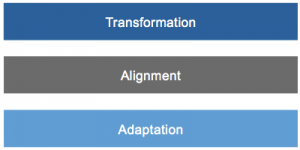The way I see it Agile Programme Management weaves together three threads: Transformation, Alignment and Adaptation. These threads are present in traditional approaches to programme management however an Agile approach subtlety changes each and increases the focus on Adaptation.
In this, the first post in a new series on Agile Programme Management, I’ll explain the three threads within Agile Programme Management.
Why “Threads”?
These threads – Transformation, Alignment and Adaptation – are not values, principles or practices because they don’t fit the pattern:
A good practice is a set of repeatable actions
that works because of some underlying principle(s)
and produces effects that support some underlying value(s)
“Theme” would have been an alright description for these things but I call them threads because, together, they form the fabric of the programme. Always present and intertwined. If they start unravelling then the whole programme goes with them.
- Attain Transformation
- Retain Alignment
- Maximise Adaptation
Okay, so what does Transformation, Alignment and Adaptation mean in the context of a programme?
Transformation
Programmes, whether traditional or agile, are fundamentally about organisational change. This transformational change is the thing that defines a programme and distinguishes it, for example, from a project. It is the single major difference between a programme and project.
Management expect benefits to result from any such transformational change – otherwise why bother. These benefits might be creating new products or services, generating greater revenue, or driving out efficiencies. Whatever the specifics the aim of any programme is to change the organisation for the better.
The point of applying an Agile approach to programme management is to make this transformation faster and hence start delivering the benefits earlier.
Alignment
Business objectives change, as does the world around us, so throughout its lifetime a programme must stay aligned with the evolving organisational strategy. Good governance ensures that programmes remain aligned to the business objectives even as they change. Poor governance can mean the programme delivers against its originally defined goals but the organisation no longer cares.
The trouble with governance is that it can get horribly bureaucratic and slow down the desired transformation. This is another area where Agile can help. Agile governance is “the application of Lean-Agile values, principles and practices to the task of governance”. Agile brings good governance, i.e. alignment, without the bureaucracy.
Adaptation
A successful programme team must adapt to the events as they unfold. This is partly about retaining alignment with changing organisational strategy but equally about responding to unforeseen events. Here are some examples of unforeseen events that I’ve had to face. Some good, some not so:
- The chosen technology is found to be wanting
- Specialist staff are hard to find
- A trial solution doesn’t offer the benefits hoped for
- Half the development funding is withdrawn
- one of the developers comes up with a stunningly innovative solution that will take half the time
- The user adoption rate far exceeds projections
- The programme starts delivering financial benefits a year ahead of schedule
So a programme manager and their team must adapt. However adaptation isn’t enough, they must also adapt quickly. This is where Agile comes in. Enabling the programme team, sponsors and other stakeholders to learn and act on that learning in a timely fashion. That increased responsiveness increases the benefits derived from the programme.
